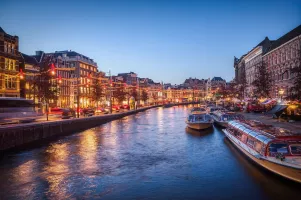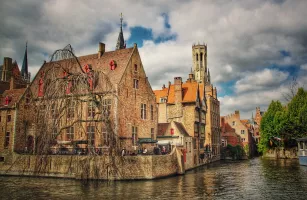The Colosseum Travel Guide
The Colosseum, also known as the Flavian Amphitheatre, is an iconic symbol of ancient Rome located in the heart of the city. Built in 70-80 AD, it is the largest amphitheatre ever built and is a testament to the grandeur and architectural prowess of the Roman Empire. The Colosseum was used for gladiatorial contests, public spectacles, and dramas, attracting thousands of spectators from all walks of life. Today, it stands as a UNESCO World Heritage Site and a must-visit destination for history buffs and architecture enthusiasts alike.Top Attractions in The Colosseum
- Explore the Colosseum's underground chambers and arena floor
- Visit the Roman Forum and Palatine Hill nearby
- Marvel at the Arch of Constantine and the nearby Capitoline Hill
- Admire the panoramic views of Rome from the top tiers of the Colosseum
- Experience a guided tour to learn about the history and significance of this ancient landmark
The Colosseum is Famous for
Its architectural grandeur and historical significance as a symbol of ancient Roman entertainment and engineering marvel.Top Attractions in The Colosseum
- Exploring the underground chambers and arena floor
- Visiting the Roman Forum and Palatine Hill nearby
- Marveling at the Arch of Constantine and the nearby Capitoline Hill
- Admiring the panoramic views of Rome from the top tiers of the Colosseum
- Experiencing a guided tour to learn about the history and significance of this ancient landmark
What's Great about Travelling to The Colosseum?
- Immerse yourself in ancient Roman history and architecture
- Experience the grandeur of one of the world's most iconic landmarks
- Witness spectacular views of Rome from the Colosseum's upper levels
- Learn about the fascinating gladiatorial contests and events that took place in the amphitheatre
What's Not So Great about Travelling to The Colosseum?
- Can get crowded with tourists, especially during peak seasons
- Limited accessibility for individuals with mobility issues due to the historic nature of the site
- Extreme weather conditions in summer can make visiting uncomfortable
- Some areas of the Colosseum may be under restoration or off-limits to visitors
Travel Tips for The Colosseum
- Book tickets in advance to skip the long lines at the entrance
- Wear comfortable shoes as there is a lot of walking involved in exploring the site
- Respect the rules and regulations of the site, such as not littering or climbing on the ruins
- Stay hydrated and carry sunscreen during hot summer months
Important The Colosseum trip information
- Ideal Duration: 1-2 days
- Best Time to Visit: Spring or Fall to avoid extreme temperatures and crowds
- Nearby Airports and Railway Stations: Rome Fiumicino Airport and Roma Termini Railway Station
Per Person
75,000
*EXCLUDING APPLICABLE TAXES 5.0 Ratings
( 393 Reviews )
( 393 Reviews )
Per Person
89,999
*EXCLUDING APPLICABLE TAXES Per Person
70,000
*EXCLUDING APPLICABLE TAXES 5.0 Ratings
( 28 Reviews )
( 28 Reviews )
Total
3,19,500
*EXCLUDING APPLICABLE TAXES 5.0 Ratings
( 24 Reviews )
( 24 Reviews )
Per Person
2,70,000
*EXCLUDING APPLICABLE TAXES Total
4,63,000
*EXCLUDING APPLICABLE TAXES 5.0 Ratings
( 24 Reviews )
( 24 Reviews )
FAQ's on The Colosseum
Q1: What is the best time to visit The Colosseum?
The best time to visit The Colosseum is during the spring and fall months, from April to June and September to November, when the weather is pleasant, and the tourist crowds are smaller. Avoid visiting in the peak summer months when temperatures soar, and the attraction is crowded. Additionally, consider visiting early in the morning or late in the afternoon to avoid the busiest times of the day.
Q2: Do I need a visa to travel to The Colosseum?
Most visitors to The Colosseum, as part of Italy, do not need a visa for short stays if they are from the European Union, the United States, Canada, Australia, and many other countries. However, it is essential to check the specific visa requirements based on your nationality and the duration of your stay.
Q3: What are the must-visit attractions in The Colosseum?
The must-visit attractions in The Colosseum include the iconic Colosseum itself, the Roman Forum, Palatine Hill, Trevi Fountain, Pantheon, and Vatican City. Don't miss out on exploring the historic streets of Rome, trying authentic Italian cuisine, and visiting the Sistine Chapel.
Q4: Is The Colosseum a safe place to travel?
The Colosseum and Rome, in general, are safe for tourists. However, like any other major city, it is essential to be cautious of pickpockets in crowded areas and avoid isolated places at night. Stay alert, keep your belongings secure, and follow common sense safety precautions.
Q5: What is the local currency in The Colosseum and can I use credit cards?
The local currency in The Colosseum is the Euro (€). Credit cards are widely accepted in most establishments, but it is advisable to carry some cash for small purchases and transactions. ATMs are also readily available throughout the city for currency exchange.
Q6: What is the local cuisine like in The Colosseum?
is a delightful mix of traditional Italian flavors. Enjoy pasta dishes like carbonara and cacio e pepe, wood-fired pizzas, fresh seafood, gelato, and espresso. Don't forget to try local specialties like supplì (fried rice balls) and Roman artichokes.
Q7: What transportation options are available in The Colosseum?
Transportation options in The Colosseum include an extensive network of buses, trams, and metro lines that connect major attractions in Rome. Taxis are also available, but it's advisable to use reputable services. Additionally, bike rentals and walking tours are popular ways to explore the city.
Q8: Are there any cultural norms or etiquette I should be aware of when visiting The Colosseum?
When visiting The Colosseum and Rome, it's essential to respect local customs and traditions. Dress modestly when visiting religious sites, greet people with a handshake, and avoid discussing sensitive topics like politics or religion. Remember to say "grazie" (thank you) and "prego" (you're welcome) as a sign of politeness.
Q9: I am a travel agent. How can I buy travel leads of The Colosseum?
Register yourself as a travel agent at agents.tripclap.com and then you can buy travel leads to The Colosseum once your account is approved. For more details contact our support team at +91-8069186564 or support@tripclap.com





